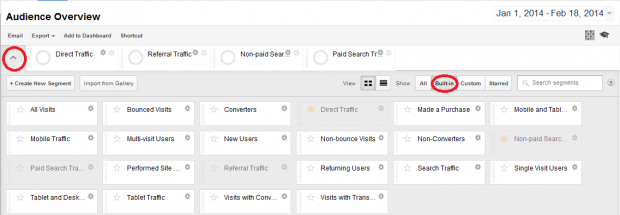When you log-in to your Google Analytics (GA) account to look at your web traffic, it may look very confusing initially. Google provides you with LOTS of data. There are several ways an internet user can find you, and Google has the analytics to track and show you how they got to your website. In GA, under Audience Overview, click on the arrow, and Google offers several built-in views that make it easy.
Every visitor to your website is another drop in your traffic bucket. If you want to remember the main sources of traffic in Google Analytics, think “A DROP“. Now you don’t want to see a drop in your numbers, but this acronym will help you remember the four main traffic sources:
A DROP:
- All Visits
- Direct Traffic
- Referral Traffic
- Organic Traffic
- Paid Traffic
All Visits – is the aggregate count of all traffic to your website. For the 30,000 foot view, its good, but let’s drill down deeper!
Direct Traffic – comes when someone types your URL into their browser, or arrives via a bookmark they’ve saved. I consider this the best one since they either 1) remember your URL from another marketing source (question: from where?) or 2) have actually bookmarked your website for future use. That’s top-of-mind awareness, baby, and that is good! Maybe they are repeat visitors who have found your product, service, content or website worthy of remembering, and have come back for more.
Referral Traffic – Its not called a “World Wide Web” for nothing. Links make the web, and some of them, if you are worthy, point to you! As your content is more and more relevant to your visitors, they’ll link to you, and that’s good. A link from another site, especially from a highly-ranked site in Google’s eyes, is a “vote” that you’re doing something noteworthy.
Organic Traffic – Google Analytics calls this Non-Paid Search Traffic. This is traffic that comes to your website when web searchers type in words related to your company and your products or services. Good onsite SEO (search engine optimization) on your website will help you look better to search engines. Organic is traffic that isn’t remembered or referred, but traffic that found you in a search query.
Paid Traffic – This is traffic from online advertising, mainly Google advertising through Google AdWords. If you tag your links via Google URL Builder you can track where they are coming from, but that is beyond the scope of this blog post. SEM (Search Engine Marketing) is an acronym for someone who works with paid traffic.
Obviously, there is more to discover using Google Analytics. Understanding these main sources of traffic to your website will help you know what to do to gain more traffic. Here at the Orion Group, we analyze web traffic for our clients to help them achieve their business goals. Call us today to see what we can do for you.


Woah this article is wonderful. I will look for other articles you write. Keep us up-to-date on the latest in web analytics! You know, plenty of people are checking around just for this kind of information and facts, you might assist them significantly.
Thanks for the memorable acronym. This makes a convoluted topic that much easier to handle. Thank you for writing this, its more understandable now.